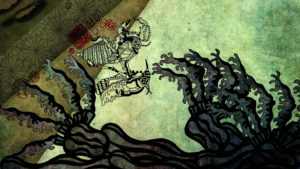 Review: Rooftop Cinema
Review: Rooftop Cinema
La Jetée | Chris Marker | France | 1962 | 29 min.
663114 | Isamu Hirabayashi | Japan | 2011 | 8 min.
Madison Museum of Contemporary Art, Friday, June 30, approx. 9:30pm»
Jason Fuhrman previews an animated short screening tonight at MMoCA’s final Rooftop Cinema this summer. He argues that 663114 develops a theme frequent in the work of Japanese animator Isamu Hirabayashi: the complex relationship between humans and their environment.
The Madison Museum of Contemporary Art concludes this summer’s Rooftop Cinema series with an increasingly relevant and timely pair of films set in dystopian futures: Chris Marker’s radical post-apocalyptic science-fiction classic La Jetée (1962) and Isamu Hirabayashi’s elliptical but hard-hitting animated short 663114 (2011).
I will post my thoughts on La Jetée in the near future, but in the meantime, this post will provide some context for the more obscure 663114 to pique your interest in Rooftop Cinema tonight.
While 663114 may require some background cultural and historical information to fully decode it, the film conveys a universal message through a clear metaphor.
The complex and uncertain relationship between human beings and the environment has been a recurring theme in the experimental films of Isamu Hirabayashi. He created 663114 as a response to the devastation wrought by the 2011 earthquake that struck Japan off the Pacific coast of Tohoku, triggering a powerful tsunami and culminating in the accident at the Fukushima Daiichi nuclear power plant. Although the title seems cryptic, Hirabayashi explained at the Berlin Film Festival that it is in fact a series of significant numbers. The Fukushima disaster occurred 66 years after the atomic bombings of Hiroshima and Nagasaki. March 11 marks the date of the Tohoku earthquake and ensuing tsunami. Furthermore, four reactors were damaged and emitting radiation at the Fukushima Daiichi plant.
Ostensibly a straightforward work of simple animation, 663114 reveals many layers upon closer examination, while raising vital questions about the future of our planet. Hirabayashi’s film focuses on the monologue of a 66-year-old cicada who steadily ascends a vertical surface representative of a tree. As he proceeds with slow, repetitive movements in a static frame, the music and groaning voices of the soundtrack cultivate a growing sense of disharmony and unease. Soon, the cicada pauses and begins to emerge from his skin in order to mate. But the great earthquake strikes when he is most vulnerable, just moments after shedding his carapace.
The resilient cicada survives, determined to continue the natural cycle of reproduction and thus complete his life. Although his offspring may live on and follow the same path, 663114 reminds viewers that the inevitable consequences of nuclear fallout have permanently altered our world.
Hirabayashi clearly wishes to highlight the seriousness of the Fukushima crisis and its aftermath. He explains that “children are being exposed to dangerous radioactivity a year after the earthquake. It is our responsibility as Japanese adults to protect the children.”
His choice of a cicada to represent the living creatures of Japan has significance for various reasons. Cicadas are among the special signifiers of summer and appear metaphorically as a symbol of rebirth in many great works of literature such as The Tale of Genji. They are also one of the longest living insects and spend much of their life cycle underground (usually 2-5 years).
The music of 663114 was composed by Osaka-based sound producer Takashi Watanabe. During the Viennale press conference for the film, he explained that they approached the soundtrack as if it were an offering to a temple. He looked to Buddhism and Shintoism in his quest to create a new kind of sacred music. They also employed Japanese food in making sound effects, such as cabbage, dried Japanese noodles, and nattō (fermented soybeans).
663114 looks like a cutout film made of washi paper and ink, but Hirabayashi constructed it using images and textures that he found on the Internet. According to him, the inkan (familiar red stamps used in lieu of signatures in Japan) that decorate the surface of the tree are a metaphor for contracts, which were given preference over people after the war. In Western society, people still use rubber stamps to make documents official and the English expression “to rubber-stamp” means to give approval automatically without consideration. Therefore the red stamps in 663114 represent the capitalistic concerns of Japan’s business empire, as well as the bureaucratic machinery that enables catastrophes like that of Fukushima to happen in the first place. Hirabayashi warns us about the dangers of radiation, but also the dangers of tradition.
By deliberately using sparse animation and parable, rather than attempting to present concrete facts or offer simplistic solutions to a difficult problem, Hirabayashi has made a deeply humanistic and politically efficacious work of art that reaches further than a specific moment in Japanese history. 663114 broadly addresses the degeneration of the planet in terms of its natural equilibrium with a highly imaginative, beautifully concise and emotionally resonant style.